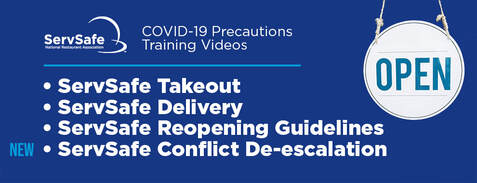Comprehensive Food Handlers Educating for Hygiene and Safety And Security
In today's swiftly developing food solution landscape, extensive food trainers training has become a vital component for ensuring hygiene and safety and security. By instilling important practices connected to hand health, food storage, and cleanliness, this training not only minimizes the danger of foodborne health problems yet additionally strengthens conformity with regulatory standards. The effects of such training prolong beyond simple conformity; they touch upon public wellness and customer trust. The effectiveness of these training programs can differ considerably. What factors truly identify their success in promoting a culture of safety and security?
Significance of Food Security Training

Additionally, food safety and security training aids to make sure that staff members know present policies and guidelines, which are essential for preserving functional licenses and preventing pricey penalties. Routine training sessions also serve as a system for strengthening finest techniques, therefore reducing the likelihood of human error, which typically works as a leading root cause of food contamination.
In addition, buying food security training can improve an establishment's online reputation, as clients increasingly focus on eating experiences that mirror high safety and security criteria. Such proactive actions not just shield consumers yet likewise add to the long-lasting success of food organizations. In recap, thorough food security training is an important element of food solution procedures, directly impacting both public wellness and company sustainability.
Secret Principles of Health
Preserving high standards of hygiene is important in any type of food handling setting to avoid contamination and make certain the safety and security of consumers. The key principles of health encompass a number of crucial methods that food handlers have to constantly apply.
First, hand health is paramount; food handlers need to clean their hands thoroughly with soap and water prior to and after handling food, along with after making use of the washroom or touching any potentially contaminated surfaces. Second of all, equipment and surface areas should be routinely cleaned up and sterilized to remove microorganisms. This includes utensils, reducing boards, and countertops, which must be preserved in a tidy condition.


Proper food storage space is likewise important; raw foods must be kept independently from prepared or ready-to-eat items to avoid cross-contamination. servsafe food handler. Furthermore, preserving ideal temperature controls is important; disposable products ought to be maintained safe temperature levels to hinder microbial development
Lastly, personal hygiene can not be overlooked. Food trainers must put on tidy clothes, use hair restraints, and stay clear of working when ill. By adhering to these crucial concepts of health, food handlers can dramatically minimize the risk of foodborne illnesses and advertise a much safer dining experience for all customers.
Typical Foodborne Diseases
Although several foodborne illnesses can be prevented via appropriate health and risk-free food dealing with techniques, they remain a substantial public recommended you read health and wellness issue. Foodborne virus can lead to a variety of diseases, varying from moderate intestinal distress to extreme issues and even fatality.
Usual foodborne health problems include salmonellosis, brought on by Salmonella germs, commonly connected to undercooked chicken and eggs. Another common disease is listeriosis, related to raw dairy items and ready-to-eat meats, which can be particularly hazardous for pregnant women and immunocompromised people. Norovirus, often gotten from polluted food or surface areas, is known for its quick spread and capability to create outbreaks in common setups.
Escherichia coli (E. coli) infection, significantly connected with undercooked ground beef and polluted fruit and vegetables, can lead to serious stomach pains and kidney failure in some situations. Furthermore, Clostridium perfringens, usually found in huge amounts of food that are incorrectly saved, can create gastrointestinal disorder with signs and symptoms appearing soon after usage.
Recognizing these diseases is critical for food trainers, as recognition my sources can substantially decrease the risk of contamination and secure public wellness. Appropriate education and training are important components in combating foodborne conditions.
Finest Practices for Food Handling
Reliable food handling practices are vital in stopping the spread of foodborne health problems. To start with, proper hand hygiene is crucial; food trainers need to clean their hands thoroughly with soap and water prior to and after handling food, particularly raw meat or fowl - servsafe certifications. This basic action significantly lowers the threat of cross-contamination
Secondly, keeping proper food storage temperatures is crucial. Perishable things must be stored at or listed below 40 ° F(4 ° C) to inhibit bacterial growth. In addition, prepared foods must be maintained above 140 ° F(60 ° C) till served.
Thirdly, making certain sanitation of surfaces and devices is crucial. Frequently disinfect countertops, cutting boards, and tools, particularly after preparing raw foods. Usage different cutting boards for raw and ready-to-eat foods to further decrease contamination threats.
Furthermore, when preparing food, it is vital to follow the concept of "first in, first out" (FIFO) to handle supply successfully and lower putridity. Lastly, always check out and adhere to food labels for secure cooking temperature levels and taking care of instructions. By executing these ideal practices, food handlers can considerably improve food safety and safeguard public health and like it wellness.
Carrying Out a Safety Culture
Developing a security society within a food taking care of setting is necessary for promoting a commitment to food safety among all team participants. This culture highlights the relevance of food security as a shared obligation, urging workers to prioritize health practices regularly.
To apply a security society, organizations need to start by providing thorough training that resolves food handling methods, possible risks, and the significance of individual health. Training sessions need to be interactive and customized to the certain duties of personnel participants, making certain relevance and involvement.
Additionally, management plays a critical function in establishing this culture. Monitoring should model risk-free practices and interact the value of food safety on a regular basis. Acknowledging and rewarding employees that promote security requirements can better strengthen these habits.
In addition, open communication networks should be established, allowing team to report safety concerns without worry of consequence. Routine safety audits and feedback sessions can assist determine locations for improvement and strengthen liability.
Eventually, growing a security culture not only improves conformity with food safety policies however likewise safeguards public health and wellness, promotes staff member spirits, and contributes to the overall success of the food managing establishment.
Final Thought
In final thought, thorough food handlers training plays a critical function in promoting hygiene and safety within food service establishments. By equipping staff members with important understanding regarding food security principles, common foodborne diseases, and best practices for managing food, such training substantially decreases health risks. Fostering a society of safety improves the establishment's online reputation and straightens with consumer expectations for high safety and security requirements, inevitably contributing to public health security and the general success of the food solution industry.
In today's quickly developing food service landscape, comprehensive food trainers training has arised as an essential element for making certain hygiene and security.Food safety and security training is vital for maintaining high standards in food handling and preparation, with research studies showing that correct training can decrease foodborne ailments by up to 30%. In summary, comprehensive food security training is an essential element of food solution procedures, directly influencing both public wellness and business sustainability.

Comments on “Recognizing the Role of a ServSafe Food Handler in Ensuring Food Safety Criteria”